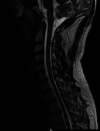Paraparesis in a patient with advanced HIV infection: a diagnostic conundrum
- PMID: 33687941
- PMCID: PMC7944965
- DOI: 10.1136/bcr-2020-240725
Paraparesis in a patient with advanced HIV infection: a diagnostic conundrum
Abstract
In patients with HIV infection, lower limb weakness is a result of the pathological involvement of the brain, spinal cord or peripheral nervous system. The pathological process can be opportunistic infections, nutrient deficiencies, neoplastic infiltration or HIV itself. Here, we present the case of a 50-year-old manual labourer who presented with gradually progressive lower limb weakness, sensory disturbances, impotence and urinary urgency. He was diagnosed with HIV during evaluation. Based on the presentation and other supportive laboratory and radiological evidence, the following differentials were considered: vacuolar myelopathy, amyotrophic lateral sclerosis and myeloradiculopathy. The patient was initiated on antiretroviral therapy, and he showed significant improvement of symptoms on follow-up. We report this case to discuss the diagnostic puzzle.
Keywords: HIV / AIDS; infection (neurology); motor neurone disease; spinal cord; tropical medicine (infectious disease).
© BMJ Publishing Group Limited 2021. No commercial re-use. See rights and permissions. Published by BMJ.
Conflict of interest statement
Competing interests: None declared.
Figures
Similar articles
-
Seropositive Neuromyelitis Optica in a Case of Undiagnosed Ankylosing Spondylitis: A Neuro-Rheumatological Conundrum.Qatar Med J. 2022 Jul 7;2022(3):29. doi: 10.5339/qmj.2022.29. eCollection 2022. Qatar Med J. 2022. PMID: 35864917 Free PMC article.
-
HIV-associated vacuolar myelopathy: A rare initial presentation of HIV.SAGE Open Med Case Rep. 2020 Jul 24;8:2050313X20945562. doi: 10.1177/2050313X20945562. eCollection 2020. SAGE Open Med Case Rep. 2020. PMID: 32782803 Free PMC article.
-
Diseases of the spinal cord in human immunodeficiency virus infection.Semin Neurol. 1999;19(2):151-5. doi: 10.1055/s-2008-1040832. Semin Neurol. 1999. PMID: 10718535 Review.
-
Presence of tropical spastic paraparesis/human T-cell lymphotropic virus type 1-associated myelopathy (TSP/HAM)-like among HIV-1-infected patients.J Med Virol. 2008 Mar;80(3):392-8. doi: 10.1002/jmv.21111. J Med Virol. 2008. PMID: 18205234
-
AIDS-associated vacuolar myelopathy.AIDS Patient Care STDS. 1998 Jun;12(6):457-61. doi: 10.1089/apc.1998.12.457. AIDS Patient Care STDS. 1998. PMID: 11361993 Review.
Cited by
-
HIV associated motor neuron disease (MND): A case series with systematic review of literature.J Neurovirol. 2025 Feb;31(1):1-15. doi: 10.1007/s13365-025-01244-z. Epub 2025 Mar 4. J Neurovirol. 2025. PMID: 40038221
References
Publication types
MeSH terms
LinkOut - more resources
Full Text Sources
Other Literature Sources
Medical

